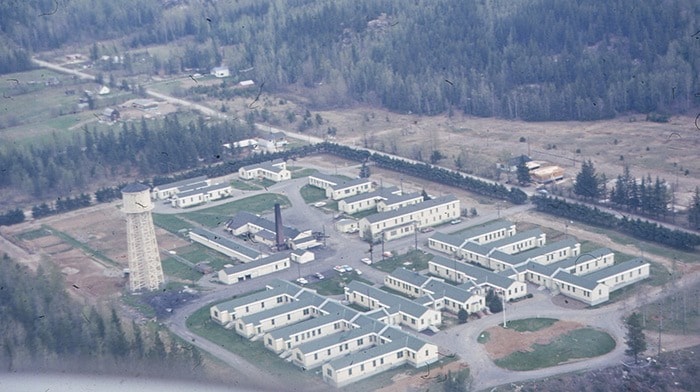(First of two parts)
By Kelsey Wiebe
Why do we need a new hospital in Terrace?
Today’s pressing concerns – crowdedness, inability to reach hygiene standards, confined quarters limiting expansion, and a general lack of specialized care in our community or region – echo many of the issues facing Terrace from the 1910s through to the 1950s.
Long before the present-day community of Terrace was surveyed and claimed, Tsimshian people living in the area considered the Lakelse Hot Springs a kind of ‘native hospital,’ according to Kitsumkalum elder Addie Turner in an oral history.
The hot springs minerals and heat were curative for skin ailments, arthritis, and pulled muscles.
When the Grand Trunk Pacific Railway began construction in the Skeena region in the early part of the 1900s, railway doctors W.P. Johns (in the area 1908/1909 to 1911) and Seymour Traynor (here 1910-1916, when he enlisted in the First World War, and again briefly in 1919) cared for the burgeoning population of railway workers, settlers, and Tsimshian people, frequently travelling by canoe between communities before the completion of the railway (and long before any road).
Dr. Johns’ home in Bateman’s Landing (near Remo) and Dr. Traynor’s office on Kalum Street near Greig Avenue were the first approximations of modern hospitals here.
Early doctoring was at times a gruesome job: Dr. Traynor signed the death certificates of the contracted workers killed in a dynamite explosion building a railway tunnel near Kitselas in February 1911.
During the Great War, when Terrace was without a doctor due to Dr. Traynor’s service in the military, the Terrace Hotel at Kalum Street and Greig Avenue was converted into a temporary hospital.
Danina Lanfear and Ethelwyn French seconded the space and nursed victims of the 1918 influenza epidemic back to health on a boiled milk diet. Farmers delivered any extra milk to the hotel each morning for free.
The hotel similarly did not charge flu patients during the month or so of the outbreak.
Lanfear and French, who were farmers and teachers (not nurses), also worked for free. All of the patients of the ad hoc hospital recovered.
Several doctors arrived in Terrace after the war, working out of a small wooden medical building just north of present-day Don Diego’s on Kalum Street.
This rough ‘hospital’ was built by Dr. Traynor during a brief return to Terrace in 1919. It only became a one-bed hospital in 1927, thanks to a fundraising effort by a community group which purchased a hospital bed and a rudimentary x-ray machine.
Dr. Stanley Gordon Mills, one of our first permanent doctors, arrived in Terrace in 1929 or 1930.
He too, operated out of the Kalum Street medical office, but quickly got frustrated by its limitations. Dr. Mills served as a doctor in England and France during the First World War, and was forced to continue much of the triage work he did overseas here, due to the lack of proper facilities.
Rosswood resident Elinor Spencer recalls in a 1978 oral interview that when a fourteen-year-old boy was shot in the stomach with a rifle in the mid-1930s, “there was no hospital, no nothing – so Dr. Mills just laid him out on the kitchen table and operated, and that boy lived.”
In addition to emergency surgery on kitchen tables, Dr. Mills was locally known for doing veterinary work and dentistry when necessary, and for accepting eggs and produce for payment during the Great Depression.
When emergency surgery was required in the evenings, he requisitioned the use of one of the few houses with electrical lighting.
Dr. Mills’ wife, Edith, was a similarly important person in Terrace’s medical history. She was a registered nurse, and colourful old-timer. Fred Hampton described her as “a good doctor, too.”
Dr. Mills’ work was assisted by his wife as well as by other women such as Caroline Doll who used to act “as a kind of midwife,” according to Edith Kawinsky.
Dr. Mills would deliver babies at her home near where the Park Avenue Medical Centre is now, and Doll would look after both the mother and baby in her home for a few days after the birth.
This, of course, was for those pregnant women who didn’t risk the lengthy train journey to Hazelton or Prince Rupert to deliver their babies in a proper hospital.
During the great Skeena River flood in 1936, the single-bed hospital was again found inadequate, and the United Church manse was converted into a temporary hospital for the many people injured or sick as a result of the flooding.
Dr. Mills, together with many concerned citizens, began advocating for a proper, purpose-built hospital after this event.
When the Second World War broke out, Dr. Mills’ efforts were temporarily shelved. A state-of-the-art 300-bed military hospital was quickly constructed on the Bench where Heritage Park Museum, Terraceview Lodge, and McConnell Estates are now located.
Here, bored army doctors awaited a Japanese invasion and the ensuing casualties, none of which ever came to pass. These doctors eagerly performed unnecessary appendectomies and tonsillectomies on willing local residents, and allowed Dr. Mills to treat his most serious cases in their quarters.
This solved, temporarily, the need for a hospital with modern equipment and adequate space.
When the Second World War ended, a new chapter in Terrace health care history was about to begin. That’s the second part of this look at the history of medical care here and it will run Feb. 8, 2017.
Kelsey Wiebe is the Curator of Heritage Park Museum.
Funnily enough, the museum’s collection doesn’t include any photos of Mills Memorial Hospital. If you have photos of the hospital throughout the years, or even of one of its precursors, consider donating them or loaning them to the museum to scan. Contact Kelsey at curator@heritageparkmuseum.com.
